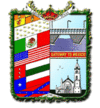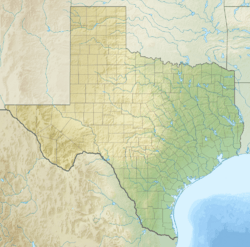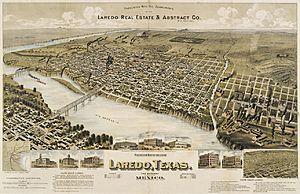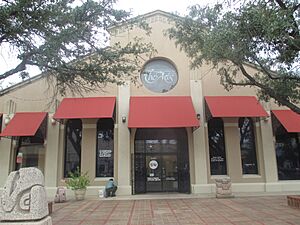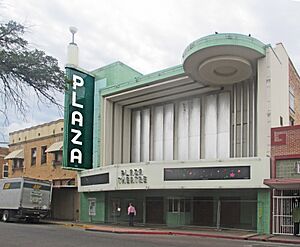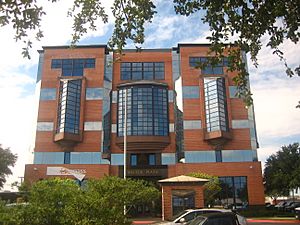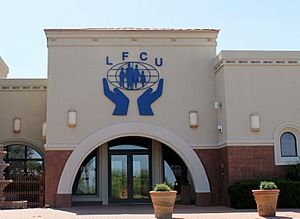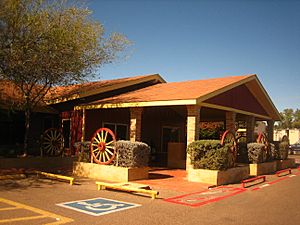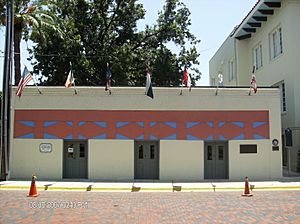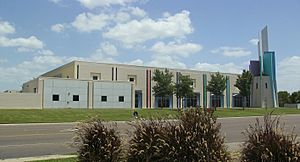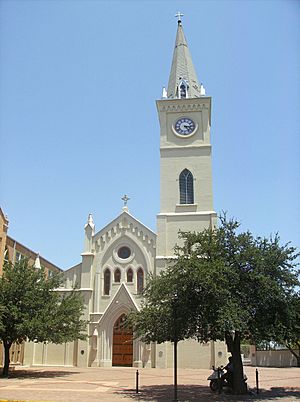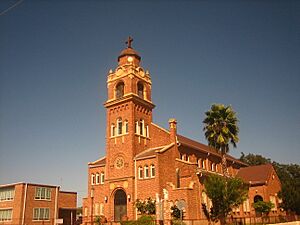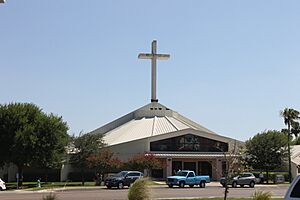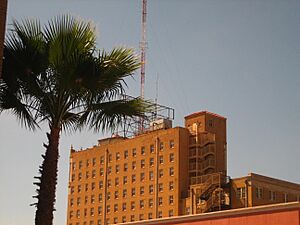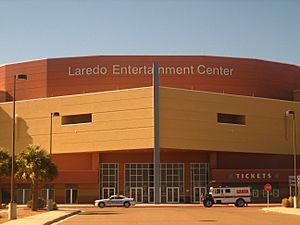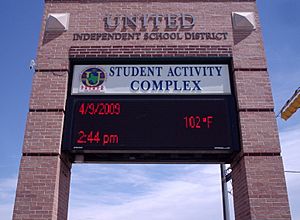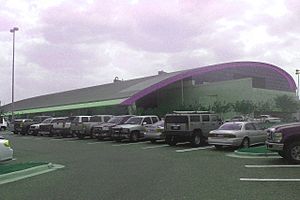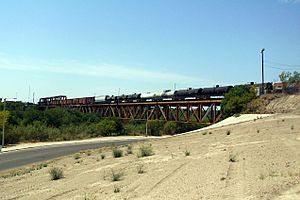Laredo, Texas facts for kids
Quick facts for kids
Laredo
|
|||
|---|---|---|---|
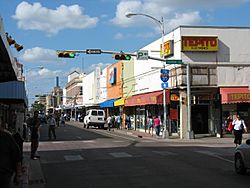
Downtown Laredo
|
|||
|
|||
| Nickname(s):
"The Gateway City" and "The City Under Seven Flags"
|
|||
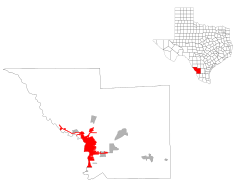 |
|||
| Country | United States | ||
| State | Texas | ||
| County | Webb | ||
| Metropolitan area | Laredo–Nuevo Laredo Metropolitan Area | ||
| Founded | August 25, 1755 | ||
| Settled as | Villa de San Agustín de Laredo | ||
| Founded by | Tomás Sánchez | ||
| Named for | Laredo, Spain | ||
| Government | |||
| • Type | Council–manager | ||
| Area | |||
| • City | 107.96 sq mi (279.61 km2) | ||
| • Land | 106.49 sq mi (275.81 km2) | ||
| • Water | 1.47 sq mi (3.80 km2) | ||
| • Metro | 161.76 sq mi (418.96 km2) | ||
| Elevation | 438 ft (137.2 m) | ||
| Population
(2020)
|
|||
| • City | 255,205 | ||
| • Estimate
(2021)
|
256,153 | ||
| • Density | 2,396.5/sq mi (925.3/km2) | ||
| • Urban | 251,462 (US: 163rd) | ||
| • Urban density | 3,916.6/sq mi (1,512.2/km2) | ||
| • Metro | 267,114 (US: 186th) | ||
| Demonyms |
|
||
| GDP | |||
| • Metro | .010 billion (2022) | ||
| Time zone | UTC−6 (CST) | ||
| • Summer (DST) | UTC−5 (CST) | ||
| ZIP Codes |
78040–78046, 78049
|
||
| Area code | 956 | ||
| FIPS code | 48-41464 | ||
| GNIS feature ID | 1339633 | ||
| Website | laredotexas.gov | ||
Laredo is a city in Texas, USA. It is the county seat of Webb County. Laredo sits on the north bank of the Rio Grande river. Across the river is Nuevo Laredo, Tamaulipas, Mexico.
The city was founded in 1755. It grew from a small village. For a short time, Laredo was the capital of the Republic of the Rio Grande. Today, it is the biggest inland port on the Mexican border. Laredo's economy mainly relies on trade with Mexico. It is a major hub for transportation by land, rail, and air cargo. The city is at the southern end of I-35. This highway connects factories in northern Mexico to trade routes across the U.S. Laredo has four international bridges and one railway bridge.
In 2020, Laredo's population was 255,205 people. This makes it the 11th largest city in Texas. It is also the third most populated U.S. city on the Mexican border. Only San Diego, California, and El Paso, Texas are larger. Laredo is part of a bigger area called the Laredo–Nuevo Laredo metropolitan area. This area has about 636,516 people.
About 95% of Laredo's population is Hispanic. This is one of the highest percentages in the United States, outside of Puerto Rico.
You can find Texas A&M International University and Laredo College in Laredo. The Laredo International Airport is also within the city. Another airport, Quetzalcoatl International Airport, is nearby in Nuevo Laredo, Mexico.
The biggest festival in Laredo is the Washington's Birthday Celebration. It happens in late January and February. This festival brings in many tourists.
Contents
- History of Laredo
- Geography and Climate
- Population and People
- Laredo's Economy
- Arts and Culture in Laredo
- Sports in Laredo
- Parks and Recreation
- Education in Laredo
- Media in Laredo
- Transportation in Laredo
- Notable People from Laredo
- Sister Cities
- See also
History of Laredo
Laredo was first settled by Spanish colonists in 1755. It was called Villa de San Agustin de Laredo. Don Tomás Sánchez Barrera founded the town. At that time, the area was part of Nuevo Santander in New Spain. Laredo was named after Laredo, Cantabria, Spain. It was also named to honor Saint Augustine of Hippo.
In 1840, Laredo became the capital of the independent Republic of the Rio Grande. This republic was formed to oppose Antonio López de Santa Anna. However, Mexican forces soon brought Laredo back into Mexico.
During the Mexican–American War in 1846, Texas Rangers took control of the town. After the war, the Treaty of Guadalupe Hidalgo gave this land to the United States. The people of Laredo voted to ask the U.S. military to return the town to Mexico. When this request was denied, many families moved across the river. They founded Nuevo Laredo in Mexico. But many others stayed and became Texans. In 1849, the U.S. Army built Fort McIntosh nearby. Laredo officially became a city again in 1852.
Laredo is one of the oldest crossing points between Mexico and the United States. It is also the nation's largest inland port for trade. In 2005, Laredo celebrated its 250th birthday.
The name "Laredo" has an interesting origin. Some experts believe it comes from glaretum, meaning "sandy, rocky place." Others think it comes from a Basque word meaning "beautiful pastures." It might also come from the Latin word larida, which means gull.
In April 2019, cellist Yo-Yo Ma brought his Bach Project to the Juarez–Lincoln International Bridge.
Geography and Climate
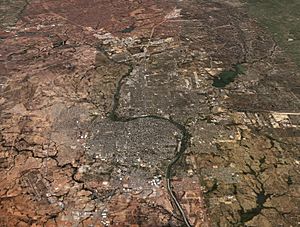
Laredo covers about 102.6 square miles (265.7 km2). A small part of this area, about 1.5 square miles (3.9 km2), is water.
Where is Laredo Located?
Laredo is on the western edge of the Rio Grande Plains. It is south of the Edwards Plateau and west of the Coastal Plains. The area has some hills and flat land. It is covered with grasses, oaks, and mesquite trees.
Water Bodies in Laredo
The Rio Grande river is a major natural feature. Lake Casa Blanca is a man-made lake on Chacon Creek. It is part of Lake Casa Blanca International State Park. The lake covers 1,650 acres (6.7 km2) of water.
Six main creeks flow into the Rio Grande. These are Chacon Creek, San Ildefonso Creek, San Ygnacio Creek, Santa Isabel Creek, Sombrerillito Creek, and Zacate Creek. There are also other man-made lakes, like the San Ildefonso Creek Lake.
Nearby Cities
Laredo is close to many cities in both Mexico and Texas.
| City | Population | Distance (km) |
|---|---|---|
| Nuevo Laredo, Tamaulipas | 373,725 | 0 mi |
| Monclova, Coahuila | 198,819 | 124 mi (200 km) |
| Monterrey, Nuevo León | 4,080,329 | 125 mi (201 km) |
| Reynosa, Tamaulipas | 589,466 | 130 mi (210 km) |
| Corpus Christi, Texas | 305,215 | 131 mi (211 km) |
| San Antonio, Texas | 1,927,407 | 154 mi (248 km) |
| Heroica Matamoros, Tamaulipas | 449,815 | 167 mi (269 km) |
| Brownsville, Texas | 183,046 | 170 mi (270 km) |
| Saltillo, Coahuila | 709,671 | 181 mi (291 km) |
Laredo's Climate
Laredo has a semiarid climate. Summers are very hot, and winters are mild. The weather is influenced by the Sierra Madre Oriental mountains to the west. The Gulf of Mexico is to the east. The Chihuahuan Desert is to the north.
The average temperature in January is about 57.6°F (14.2°C). In August, it rises to about 89.1°F (31.7°C). Record temperatures have ranged from 11°F (-12°C) to 115°F (46°C). On average, temperatures reach 100°F (38°C) or higher about 74 days a year. Freezing temperatures happen about 4 or 5 days a year.
Laredo gets about 19.7 inches (500 mm) of rain each year. Most rain falls from May to October. Snowfall is rare. The last measurable snow was in December 2017.
Population and People
| Historical population | ||
|---|---|---|
| Year | Pop. | ±% |
| 1757 | 85 | — |
| 1770 | 185 | +117.6% |
| 1790 | 708 | +282.7% |
| 1820 | 1,430 | +102.0% |
| 1830 | 2,052 | +43.5% |
| 1860 | 1,256 | −38.8% |
| 1870 | 2,046 | +62.9% |
| 1880 | 3,521 | +72.1% |
| 1890 | 11,319 | +221.5% |
| 1900 | 13,429 | +18.6% |
| 1910 | 14,855 | +10.6% |
| 1920 | 22,710 | +52.9% |
| 1930 | 32,618 | +43.6% |
| 1940 | 39,274 | +20.4% |
| 1950 | 51,910 | +32.2% |
| 1960 | 60,678 | +16.9% |
| 1970 | 69,678 | +14.8% |
| 1980 | 91,449 | +31.2% |
| 1990 | 122,899 | +34.4% |
| 2000 | 176,576 | +43.7% |
| 2010 | 236,091 | +33.7% |
| 2020 | 255,205 | +8.1% |
| U.S. Decennial Census Texas Almanac: 1850–2010 Source: U.S. Decennial Census |
||
Laredo's Diverse Population
In 2020, Laredo had 255,205 residents. There were 72,328 households and 58,294 families.
| Race | Number | Percentage |
|---|---|---|
| White (NH) | 9,181 | 3.6% |
| Black or African American (NH) | 773 | 0.3% |
| Native American or Alaska Native (NH) | 131 | 0.05% |
| Asian (NH) | 1,290 | 0.51% |
| Pacific Islander (NH) | 25 | 0.01% |
| Some other race (NH) | 450 | 0.18% |
| Mixed/multiracial (NH) | 537 | 0.21% |
| Hispanic or Latino | 242,818 | 95.15% |
| Total | 255,205 |
In 2010, Laredo was the 81st most populated city in the U.S. It was the 10th largest in Texas. The population was 236,091 people.
Most of Laredo's population is of Hispanic origin (95.6%). Many identify as Mexican (86.9%). About 84.3% of the population identifies as white Hispanic. Only 4.4% of the population was not Hispanic or Latino.
In 2005, there were 99,675 males and 108,112 females. The average household had 3.69 people. The population density was about 2,250.5 people per square mile.
About 35.5% of the population was under 18 years old. The median age was 27 years. For every 100 females, there were 92.2 males.
In 2000, Laredo was the second-fastest growing city in the United States. Only Las Vegas grew faster.
Laredo's Economy
Laredo is the largest inland port in the United States. Nuevo Laredo is the largest in Latin America. This is because of their location and the North American Free Trade Agreement (NAFTA). Many factories and trade agencies help with international trade. In January 2014, Laredo handled $20 billion in trade with Mexico. This was about half of all U.S. trade with Mexico that month.
Laredo is also a popular shopping spot for people from Northern Mexico. However, the number of Mexican shoppers has sometimes gone down due to safety concerns in Nuevo Laredo.
International Trade in Laredo
More than 47% of U.S. trade going to Mexico passes through Laredo. Over 36% of Mexican trade also crosses here. Laredo's economy depends on commercial and industrial warehouses, and importing and exporting goods. The North American Free Trade Agreement helped Laredo's trade grow a lot. Laredo has four international bridges for crossing the Rio Grande. A fifth bridge is being planned.
Shopping in Laredo
Laredo's retail stores attract shoppers from Mexico and South Texas. The city has one indoor shopping mall, Mall del Norte. There is also The Outlet Shoppes at Laredo. Many other shopping centers are spread throughout the city. The Streets of Laredo Urban Mall is a group of businesses working to improve the historic downtown area.
Job Market in Laredo
In October 2007, Laredo's jobs were mostly in:
- Trade, Transportation, and Utilities (32%)
- Education and Health Services (15%)
- Government (23%)
- Leisure and Hospitality (10%)
Laredo has seen good job growth since the mid-1990s. This is mainly due to increased international trade from NAFTA. In 2007, the job growth rate was 2.5%. The unemployment rate was 4.1%. This was a big improvement from over 15% in the mid-1990s.
Laredo's strong focus on international trade can also be a challenge. Its economy can be affected by changes in Mexico's economy. It also depends on immigration laws and daily border crossings.
Top Employers in Laredo
| Employer | Category | Employees |
| United Independent School District | Education | 6,179 |
| Laredo Independent School District | Education | 4,500 |
| City of Laredo | Government | 2,371 |
| Laredo Sector Border Patrol | Immigration | 2,000 |
| H-E-B | Grocery | 1,626 |
| Webb County | Government | 1,500 |
| Laredo Medical Center | Health care | 1,300 |
| Texas A&M International University | Education | 1,215 |
| McDonald's | Food | 1,200 |
| Walmart | Retail | 937 |
| Concentrix (formerly Convergys) | Call Center | 860 |
| Doctors Hospital | Health Care | 811 |
| International Bank of Commerce | Financial Services | 661 |
| Stripes Convenience Stores | Retail/Convenience | 337 |
| Laredo Energy Arena | Entertainment | 293 |
| Falcon International Bank | Financial Services | 292 |
Cattle Ranching in Laredo
Laredo is an important center for cattle ranching in Texas. Researchers are working to prevent the spread of certain ticks that affect cattle. The main office for the country's Cattle Fever Tick Eradication Program is in Laredo.
Arts and Culture in Laredo
Annual Celebrations
The Washington's Birthday Celebration is a month-long event. It celebrates George Washington's birthday. It is the largest event of its kind in the U.S., with 400,000 visitors. The celebration started in 1898. It includes parades, a carnival, an air show, fireworks, and concerts. The related Jalapeño Festival is one of the top eating festivals in the U.S.
Jamboozie is held in late January. It is part of the Washington's birthday celebrations. It is a colorful event, similar to New Orleans' Mardi Gras. Many people wear beads, masks, and bright outfits.
Museums to Explore
The Republic of the Rio Grande Museum is in downtown Laredo. It is next to the historic La Posada Hotel. This building was once the Capitol of the short-lived Republic of the Rio Grande. It shows items from the 19th century Laredo area. You can see pictures, books, and furniture. Guided tours are available for kids and adults. Because of this Republic, Laredo has flown seven flags, not just the usual Six Flags over Texas.
The Laredo Center for the Arts is also downtown. It has three art galleries. The Center for the Arts shows local artwork. It also hosts community events for children and adults. The Laredo Little Theater offers live stage performances and comedy shows.
The Imaginarium of South Texas is in Mall del Norte. It offers hands-on science, technology, and art experiences for kids. A second museum is planned at Texas A&M International University.
The Nuevo Santander Museum Complex includes restored buildings from Fort McIntosh. It has historical photos of the fort. There is also a science and technology museum.
Laredo's Planetarium
The Lamar Bruni Vergara Science Center Planetarium is at Texas A&M International University. The planetarium shows an accurate image of the night sky. It displays the movements of the Sun, Moon, planets, and constellations.
Laredo Public Library
The Joe A. Guerra Laredo Public Library first opened in 1916. In 1998, a new main library opened. It is about 60,000 square feet (5,600 m2). Laredo has a main library and two branches. Two new libraries opened in 2014.
Churches and Architecture
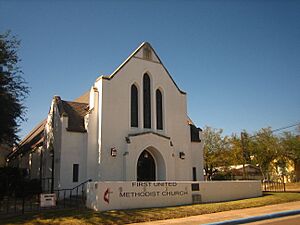
Most of Laredo's buildings show Spanish Colonial, American, and Mexican styles. Many Spanish Colonial buildings are in downtown Laredo. Modern American architecture can be seen along Interstate Highway 35.
Our Lady of Guadalupe is a large church. It was designed by Leo M. J. Dielmann. He was a popular architect for Catholic buildings. The First United Methodist Church and Christ Church Episcopal were designed by Henry Steinbomer. Other churches in Laredo include Baptist, Presbyterian, Lutheran, Assembly of God, and Mormon congregations.
Historic Places in Laredo
Several places in Laredo are listed on the National Register of Historic Places:
- Barrio Azteca Historic District
- Fort McIntosh
- San Agustin de Laredo Historic District
- Hamilton Hotel, the tallest building in Laredo
- U.S. Post Office, Court House, and Custom House
- Webb County Courthouse, finished in 1909
Tallest Buildings in Laredo
| Rank | Building Name | Height | Floors | Year Built |
|---|---|---|---|---|
| 01 | Hamilton Hotel | 150 ft (46 m) | 12 | 1923 |
| 02 | San Agustin Cathedral | 141 ft (43 m) | N/A | 1872 |
| 03 | Rio Grande Plaza | – | 15 | 1975 |
| 04 | Holiday Inn Laredo | – | 14 | 1984 |
| 05 | Laredo National Bank | – | 10 | 1926 |
| 06 | Senior Citizens Home | – | 8 | – |
| 07 | Laredo Medical Center | – | 7 | 1999 |
| 08 | Gateway Inn | – | 6 | – |
| 09 | Rialto Hotel | – | 6 | 1925 |
| 10 | Walker Plaza | – | 5 | 1995 |
Laredo in Movies and Music
Film and Television
Streets of Laredo is a 1949 Western movie. It stars William Holden. It's about three outlaws who save a young girl. Two of them become Texas Rangers.
In 1958, ABC aired an episode called "Ambush in Laredo." It was part of the TV show Texas John Slaughter.
The 1959 Western movie, Gunmen from Laredo, stars Robert Knapp. It's about a man wrongly accused of murder. He escapes to find the real killer of his wife.
The 1983 film Eddie Macon's Run is based on a novel. It features John Schneider as Eddie Macon. He escapes prison and heads to Laredo to join his family in Mexico.
Lone Star is a 1996 mystery film. It was filmed in Del Rio, Eagle Pass, and Laredo.
Music Inspired by Laredo
Laredo has been mentioned in several popular songs. One famous song is "Streets of Laredo." It was originally called "A Cowboy's Lament." Many artists have recorded it, like Johnny Cash and Marty Robbins. It was even in a Charlie's Angels episode. Another song is "Laredo Tornado" by the British band ELO.
Marty Robbins' 1966 album The Drifter included "Meet Me Tonight in Laredo."
From 1959 to 1972, a six-member singing group called The Rondels was popular in Laredo. They performed many shows and packed the Laredo Civic Center Auditorium.
Sports in Laredo
Current Sports Teams
Laredo Heat Soccer Team
The Laredo Heat is a soccer team in the United Soccer Leagues Premier Development League. Their home stadium is the Texas A&M International University Soccer Complex. The team started in 2004. In 2007, the Laredo Heat won the PDL championship. They are now part of the National Premier Soccer League and the United Premier Soccer League.
Tecolotes de los Dos Laredos Baseball Team
The Tecolotes de los Dos Laredos (Owls of the Two Laredos) is a baseball team. They play in the Mexican League. The team splits its home games between Parque la Junta in Nuevo Laredo and Uni-Trade Stadium in Laredo.
Former Sports Teams
Laredo has been home to several other sports teams in the past.
| Club | Sport | League | Venue | Championships | Years Active |
|---|---|---|---|---|---|
| Laredo Apaches | Baseball | Texas–Louisiana League | Veterans Field | 0 | 1995 |
| Laredo Broncos | Baseball | United League Baseball | Veterans Field | 0 | 2006–2010 |
| Laredo Bucks | Ice hockey | Central Hockey League | Laredo Energy Arena | 2 | 2002–2012 |
| Laredo Bucks | Ice hockey | USA Central Hockey League | Sames Auto Arena | 0 | 2018 |
| Laredo Honey Badgers | Indoor soccer | Professional Arena Soccer League | Laredo Energy Arena | Never | |
| Laredo Law | Arena football | AF2 | Laredo Energy Arena | 0 | 2003–2004 |
| Laredo Lemurs | Baseball | AAIPB | Uni-Trade Stadium | 1 | 2012–2016 |
| Laredo Lobos | Arena football | AF2 | Laredo Energy Arena | 0 | 2005–2007 |
| Laredo Rattlesnakes | Indoor football | Lone Star Football League | Laredo Energy Arena | 0 | 2011–2013 |
| Laredo Roses | Women's Football | Sugar N Spice Football League | Uni-Trade Stadium | 2012–2016 | |
| Laredo Swarm | Basketball | American Basketball Association | Laredo Energy Arena | 2015–2017 | |
| Tecolotes de los Dos Laredos | Baseball | Mexican Baseball League | Veterans Field | 5 | 1985–2004 |
| Toros de Los Dos Laredos | Basketball | Liga Nacional de Baloncesto Profesional | Laredo Energy Arena | 2 | 2007–2013 |
The Laredo Lemurs were a professional baseball team. They played from 2012 to 2016. They won the league championship in 2015. The Laredo Swarm was a semi-professional basketball team. They played from 2015 to 2017.
Stadiums and Arenas
Sames Auto Arena
The Sames Auto Arena is a large venue in Laredo. It cost $36.5 million to build. It can hold 8,002 people for ice hockey and arena football. For concerts, it can hold up to 10,000 people. It has luxury suites and meeting rooms. The arena opened in 2002. It hosts many events, like sports games, concerts, and shows. Famous artists like Lil Wayne, Rihanna, and Shakira have performed here.
Uni-Trade Stadium
The Uni-Trade Stadium is Laredo's newest baseball field. It is near the Sames Auto Arena. The city council approved its construction. The stadium was home to the Laredo Lemurs from 2012 to 2016. Since 2018, the Tecolotes de los Dos Laredos play half of their home games here.
Student Activity Complex
The United Independent School District uses the Student Activity Complex for sports. It has the city's first artificial grass stadium. It opened in 2002. The stadium can hold 8,500 spectators. It was also home to the Laredo Heat soccer team.
Texas A&M International University Soccer Complex
The Texas A&M International University Soccer Complex was built in 2006. It has two soccer stadiums. Each stadium can seat four thousand people. It is the home stadium for the Laredo Heat. It also hosts the TAMIU Dustdevils soccer teams.
Shirley Field
Shirley Field was built in 1937. It is used for outdoor sports for Laredo Independent School District. It also hosts the annual Border Olympics. The stadium can seat about 6,000 fans. It was rebuilt in 2011 and now seats 8,000 fans. It has artificial turf.
Krueger Field
Krueger Field is in north Laredo. It is owned by United Independent School District. The stadium can hold 5,000 people. It is used for high school football and soccer games. It is home to United High School's teams.
Veterans Field
Veterans Field is a baseball park with 5,000 seats. It was once known as West Martin Field. It is being renovated. Veterans Field was home to the Mexican Baseball League team Tecolotes de los Dos Laredos from 1985 to 2003. It is also home to the Texas A&M International University's Dustdevils baseball team.
Laredo Civic Center
Before the Sames Auto Arena was built, most major concerts and shows were held at the Laredo Civic Center. It has an auditorium with 1,979 seats. It also has a banquet and exhibit hall.
Parks and Recreation
Lake Casa Blanca International State Park
Lake Casa Blanca International State Park has a large artificial lake. It covers 1,680 acres (6.8 km2). You can enjoy cooking out, camping, picnicking, lake swimming, skiing, boating, and mountain biking here. Fishing is very popular. The park is a favorite spot for winter Texans.
Golf Courses in Laredo
Laredo has three 18-hole golf courses:
- The Laredo Country Club
- The Casa Blanca Golf Course
- Max A. Mandel Municipal Golf Course
The Laredo Country Club is a private course. It opened in 1983. The Casa Blanca Golf Course opened in 1967. The Max A. Mandel Municipal Golf Course opened in 2012.
Parks, Centers, and Plazas
The City of Laredo has eight recreational centers. It also has thirty-four developed parks and twenty-two undeveloped parks. There are five baseball fields and four plazas. The parks cover a total area of 618 acres (2.5 km2).
David B. Barkley Plaza
A memorial was built in Laredo in 2002. It honors 41 Hispanic soldiers who received the Medal of Honor. The plaza is named after David B. Barkley, the only Laredo Medal of Honor recipient. The plaza has a bronze statue of David B. Barkley. It also has an American flag that is 100 feet by 50 feet. The flagpole is 308 feet tall, making it the tallest in the United States.
Education in Laredo
Schools for All Ages
Two main school districts serve Laredo: the Laredo Independent School District (LISD) and the United Independent School District (UISD). There are also eight private schools.
The Laredo Independent School District (LISD) serves central Laredo. Its high schools include Cigarroa High School, Martin High School, and J. W. Nixon High School. LISD also has special magnet schools for health science, engineering, and fine arts.
The United Independent School District (UISD) serves the rest of Laredo and northern Webb County. UISD high schools include John B. Alexander High School, Lyndon B. Johnson High School, and United High School. UISD also has magnet schools for health science, engineering, and business. UISD is one of the fastest-growing school districts in Texas. It serves almost 40,000 students.
Several private schools are in the city:
- Saint Augustine High School, a Catholic school, for grades 9-12.
- Laredo Christian Academy, for grades PK-12.
- United Day School, for grades PK-8.
- Mary Help of Christians School, a Catholic school, for grades PK-8.
- Blessed Sacrament School, a Catholic school, for grades PK-7.
- Our Lady of Guadalupe School, a Catholic school, for grades PK-6.
- St. Peter Memorial School, a Catholic school, for grades PK-6.
- Saint Augustine School, a Catholic school, for grades PK-8.
Laredo also has several charter schools, like Gateway Academy.
Colleges and Universities
Laredo is home to Laredo College and Texas A&M International University (TAMIU). The University of Texas Health Science Center at San Antonio also has a campus here.
Laredo College has two campuses. It offers two-year Associate's degrees. The main campus is downtown, on the site of the old Fort McIntosh. Many old fort buildings have been turned into modern classrooms. The newer campus, Laredo College South Campus, is in south Laredo.
Texas A&M International University offers bachelor's and master's degrees. In 2004, it was approved to offer its first PhD degree. TAMIU's business school is recognized as outstanding. The university's campus is in Northeast Laredo.
The University of Texas Health Science Center campus is in East Laredo. It offers doctoral degrees in medical and dental fields.
Media in Laredo
Newspapers
Laredo has several newspapers, including:
| Name | Frequency | Language | City |
| Laredo Morning Times | Daily | English | Laredo |
| El Mañana / Laredo Sun | Daily | Spanish / English | Nuevo Laredo/Laredo |
Television Stations
Laredo has several TV stations. The first station, KGNS, started broadcasting in 1956.
| VC | Callsign | Network | City of License |
| 1.1 | XHLNA | Azteca Uno | Nuevo Laredo |
| 2.1 | XHLAR | Las Estrellas | Nuevo Laredo |
| 3.1 | XHCTNL | Imagen Televisión | Nuevo Laredo |
| 4.1 | XHBR | Televisa Nuevo Laredo | Nuevo Laredo |
| 6.1 | XHNAT | Multimedios Plus | Nuevo Laredo |
| 7.1 | XHLAT-TDT | Azteca 7 | Nuevo Laredo |
| 8.1 | KGNS | NBC | Laredo |
| 8.2 | KGNS-DT2 | ABC | Laredo |
| 8.3 | KGNS-DT3 | Telemundo | Laredo |
| 10.1 | KXNU | Telemundo | Laredo |
| 13.1 | KYLX | CBS | Laredo |
| 13.2 | KYLX-LD2 | The CW | Laredo |
| 15.1 | KLMV | MeTV | Laredo |
| 17.1 | XEFE | Once TV | Nuevo Laredo |
| 27.1 | KLDO | Univision | Laredo |
| 31.1 | KXOF | Fox / MyNet | Laredo |
| 39.1 | KETF | Unimas | Laredo |
Radio Stations
Laredo has many radio stations, both AM and FM.
| Frequency | Callsign | Brand | Format | City of License |
| 88.1 | KHOY | Catholic Radio | Religious | Laredo |
| 88.9 | XHLDO | Radio Tamaulipas | Public Radio | Nuevo Laredo |
| 89.9 | KBNL | Radio Manantial | Spanish religious | Laredo |
| 91.3 | XHNOE | Stereo 91 | Spanish Contemporary | Nuevo Laredo |
| 92.7 | KJBZ | Z93 | Tejano | Laredo |
| 94.1 | XHTLN | Imagen / RMX Laredo | Talk / Contemporary | Nuevo Laredo |
| 94.9 | KQUR | Digital 94.9 | Spanish Pop | Laredo |
| 95.7 | XHBK | Mega 95.7 | Spanish Contemporary | Nuevo Laredo |
| 97.1 | XHNLO | La Caliente | Norteño | Nuevo Laredo |
| 98.1 | KRRG | Big Buck Country | Country | Laredo |
| 99.3 | XHNK | 40 Principales | Top 40 | Nuevo Laredo |
| 100.5 | KBDR | La Ley | Tejano | Laredo |
| 101.5 | XHAS | Ke Buena | Norteño | Nuevo Laredo |
| 102.3 | XHMW | Stereo Vida | AC/Oldies | Nuevo Laredo |
| 104.9 | XHNLR | Radio UAT | University Radio | Nuevo Laredo |
| 106.1 | KNEX | Hot 106.1 | Urban / Rhythmic Top 40 | Laredo |
| 107.3 | XHGTS | 107.3 Me Gusta | Spanish Pop | Nuevo Laredo |
Transportation in Laredo
Getting Around Laredo
In 2016, most working Laredo residents (82.3%) drove alone to work. About 10.2% carpooled. A small number used public transportation (0.9%) or walked (1.9%).
In 2016, about 5.9% of Laredo households did not own a car. This is lower than the national average of 8.7%. Laredo households owned an average of 1.85 cars.
Air Travel
Laredo is served by the Laredo International Airport. You can find daily flights to Houston and Dallas/Fort Worth. Flights to Las Vegas are available three times a week. After the Laredo Air Force Base closed, the city turned it into a municipal airport. A new passenger terminal was built to handle more flights and passengers. Air cargo companies like DHL, FedEx, and UPS also use the airport. Laredo also has two medical helipads at its hospitals.
Public Transportation
El Metro is Laredo's public transit system. It has 21 bus routes and services for people with disabilities. About 4.6 million passengers use it each year. El Metro has over 47 buses and 2 trolleys. The main hub is the El Metro Transit Center in downtown Laredo. This center also houses Greyhound Lines.
Rural Transportation
The Webb County government provides rural transportation. It is called "El Aguila Rural Transportation" (the Eagle). El Aguila buses serve rural communities like Bruni and Rio Bravo. They connect these areas to the downtown El Metro Transit Center.
Road Bridges Connecting Laredo
Laredo has several international bridges:
| Bridge | Bridge number | Location | Opened | Pedestrians | Non-commercial vehicles | Commercial vehicles |
|---|---|---|---|---|---|---|
| Gateway to the Americas International Bridge | 1 | San Agustin Historical District | 1889/1954 | Yes | Yes | No |
| Juárez–Lincoln International Bridge | 2 | Southern terminus of Interstate 35 | 1976 | No | Yes | limited (e.g. buses) |
| Colombia-Solidarity International Bridge | 3 | Nuevo León, Mexico / Texas border | 1992 | Yes | Yes | Yes |
| World Trade International Bridge | 4 | Northern Terminus of Loop 20, Western terminus of Interstate 69W, Western terminus of U.S. Highway 59 |
2000 | No | No | Yes |
A fifth international bridge, Laredo 4/5 International Bridge, is proposed. It would be south of Laredo.
Rail Bridges
Laredo also has railway bridges:
| Bridge | Bridge number | Location |
|---|---|---|
| Texas-Mexican Railway International Bridge (Laredo International Railway Bridge) | 1 | Southwest Laredo, Texas |
| Texas-Mexican Railway International Bridge 2 (Currently Under Construction As of April 11, 2023.) | Southwest Laredo, Texas |
Proposed rail bridges include the Union Pacific International Railway Bridge project and the Laredo-Colombia International Railway Bridge 3.
Major Highways in Laredo
Important highways in Laredo include:
 Interstate 35 goes from Laredo to Duluth.
Interstate 35 goes from Laredo to Duluth. Interstate 69W goes from Laredo to Victoria.
Interstate 69W goes from Laredo to Victoria. U.S. Highway 59 goes from Laredo to Lancaster.
U.S. Highway 59 goes from Laredo to Lancaster. U.S. Highway 83 connects Brownsville to Laredo and then to Westhope.
U.S. Highway 83 connects Brownsville to Laredo and then to Westhope. State Highway 255 connects Laredo to Colombia.
State Highway 255 connects Laredo to Colombia. State Highway 359 goes from Laredo to Skidmore.
State Highway 359 goes from Laredo to Skidmore. State Loop 20 is a loop around Laredo.
State Loop 20 is a loop around Laredo. Farm to Market Road 1472 connects Laredo to the Colombia Solidarity International Bridge.
Farm to Market Road 1472 connects Laredo to the Colombia Solidarity International Bridge.
Major highways in Nuevo Laredo, Mexico, include:
 Mexican Federal Highway 85 from Nuevo Laredo to Mexico City.
Mexican Federal Highway 85 from Nuevo Laredo to Mexico City. Mexican Federal Highway 2 from Matamoros to Nuevo Laredo and Ciudad Acuña.
Mexican Federal Highway 2 from Matamoros to Nuevo Laredo and Ciudad Acuña.
Notable People from Laredo
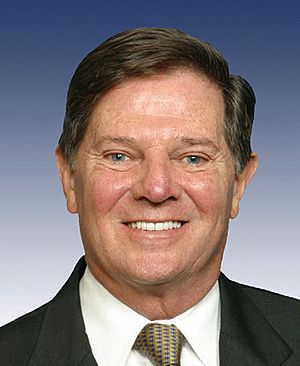
Many interesting people have come from Laredo or have strong ties to the city.
Born in Laredo
- Pedro "Pete" Astudillo, a composer.
- David Barkley-Cantu, the first Mexican-American to receive the Medal of Honor.
- Freddie Benavides, a former professional baseball player.
- Santos Benavides, a Confederate States of America colonel.
- Kaleb Canales (born 1978), an assistant coach for the Indiana Pacers basketball team.
- Quico Canseco, a Republican U.S. Representative.
- Orlando Canizales, a professional boxer.
- Francisco G. Cigarroa, a former chancellor of the University of Texas System.
- Henry R. Cuellar, a Democrat U.S. Representative since 2005.
- Tony Dalton, an actor and screenwriter.
- Elizabeth De Razzo (born 1980), an actress.
- Tom DeLay, a former U.S. Representative and House Majority Leader.
- Elma Salinas Ender (born 1953), the first Hispanic woman state court judge in Texas.
- Audrey Esparza (born 1986), an actress.
- Betty Flores (born 1944), the first woman mayor of Laredo (1998–2006).
- Alfonso Gomez-Rejon (born 1973), a film and television director.
- Carla Gonzalez (born 2001), a professional wrestler.
- Armando Hinojosa (born 1944), a sculptor.
- Jovita Idar (1885–1946), a Mexican-American journalist and civil rights worker.
- John King, a professional baseball pitcher for The Texas Rangers.
- Rodney Lewis (born 1954), an oil and natural gas industrialist.
- Sebastián Ligarde (born 1954), an actor.
- Thomas C. Mann (1912–1999), a key figure in U.S. Latin America policy.
- César A. Martínez (born 1944), a prominent artist.
- Carlos Mercado (born 1999), a soccer player.
- Alicia Dickerson Montemayor, a Democratic political activist and educator.
- Amado Maurilio Peña Jr. (born 1943), an American visual artist.
- Federico Peña, a former mayor of Denver and U.S. Secretary.
- William Merriweather Peña (1919–2018), an architect.
- Roel Ramírez (born 1995), a professional baseball player.
- Ana Rodriguez, a Miss USA finalist.
- Johnny Rodriguez, a Tex-Mex Country singer.
- Pete Saenz (born 1951), the mayor of Laredo since 2014.
- Poncho Sanchez (born 1951), a conga player and Latin jazz bandmaster.
- Antonio R. "Tony" Sanchez Jr., an oilman and banker.
- Kathleen King von Alvensleben, an architect.
- Peggy Webber (born 1925), an actress.
- Judith Zaffirini (born 1946), the first Latina elected to the Texas State Senate.
Other Notable People Connected to Laredo
- Steve Asmussen (born 1965), a horse breeder.
- Thomas Haden Church, an actor.
- Edmund J. Davis (1827–1883), a former governor of Texas.
- Jack Lanza, a former professional wrestler and WWE producer.
- Juan L. Maldonado (born 1948), a former president of Laredo Community College.
- Saul N. Ramirez Jr., mayor of Laredo from 1990 to 1998.
- Richard Peña Raymond, a state representative.
- Jerry D. Thompson (born 1943), a historian.
- Jeremy Vuolo, a former American soccer player.
Sister Cities
Laredo has many sister cities around the world. In July, Laredo hosts the Laredo International Sister Cities Festival. This festival is a big event for business, trade, tourism, and culture. All of Laredo's sister cities are invited to join. In 2004, the festival won an award for the best overall program from Sister Cities International.
Laredo's sister cities include:
 Acámbaro, Mexico (2004)
Acámbaro, Mexico (2004) Campeche, Mexico
Campeche, Mexico Cerralvo, Mexico
Cerralvo, Mexico Chenzhou, China (2001)
Chenzhou, China (2001) Ciénega de Flores, Mexico (1987)
Ciénega de Flores, Mexico (1987) Ciudad Valles, Mexico
Ciudad Valles, Mexico La Cruz, Costa Rica
La Cruz, Costa Rica Cuernavaca, Mexico
Cuernavaca, Mexico General Escobedo, Mexico
General Escobedo, Mexico General Terán, Mexico
General Terán, Mexico Guadalajara, Mexico
Guadalajara, Mexico Guadalupe, Mexico (2000)
Guadalupe, Mexico (2000) Los Herreras, Mexico
Los Herreras, Mexico Hutt, New Zealand
Hutt, New Zealand Jerez, Mexico (1987)
Jerez, Mexico (1987) Lampazos de Naranjo, Mexico (2000)
Lampazos de Naranjo, Mexico (2000) Laredo, Spain (1978)
Laredo, Spain (1978) Lázaro Cárdenas, Mexico
Lázaro Cárdenas, Mexico León, Mexico
León, Mexico Mexticacán, Mexico (2002)
Mexticacán, Mexico (2002) Monclova, Mexico (2003)
Monclova, Mexico (2003) Montemorelos, Mexico
Montemorelos, Mexico Murray Bridge, Australia (1984)
Murray Bridge, Australia (1984) Nuevo Laredo, Mexico (1986)
Nuevo Laredo, Mexico (1986) Papantla, Mexico
Papantla, Mexico San Antonio de Areco, Argentina
San Antonio de Areco, Argentina San Miguel de Allende, Mexico (2001)
San Miguel de Allende, Mexico (2001) Tainan, Taiwan
Tainan, Taiwan Tepatitlán de Morelos, Mexico
Tepatitlán de Morelos, Mexico Tijuana, Mexico
Tijuana, Mexico Tlahualilo, Mexico (1988)
Tlahualilo, Mexico (1988) Tonalá, Mexico
Tonalá, Mexico Torreón, Mexico 2004)
Torreón, Mexico 2004) Veracruz, Mexico (1992)
Veracruz, Mexico (1992) Wenzhou, China
Wenzhou, China Wuwei, China (2004)
Wuwei, China (2004) Zixing, China (2002)
Zixing, China (2002)
See also
 In Spanish: Laredo (Texas) para niños
In Spanish: Laredo (Texas) para niños



